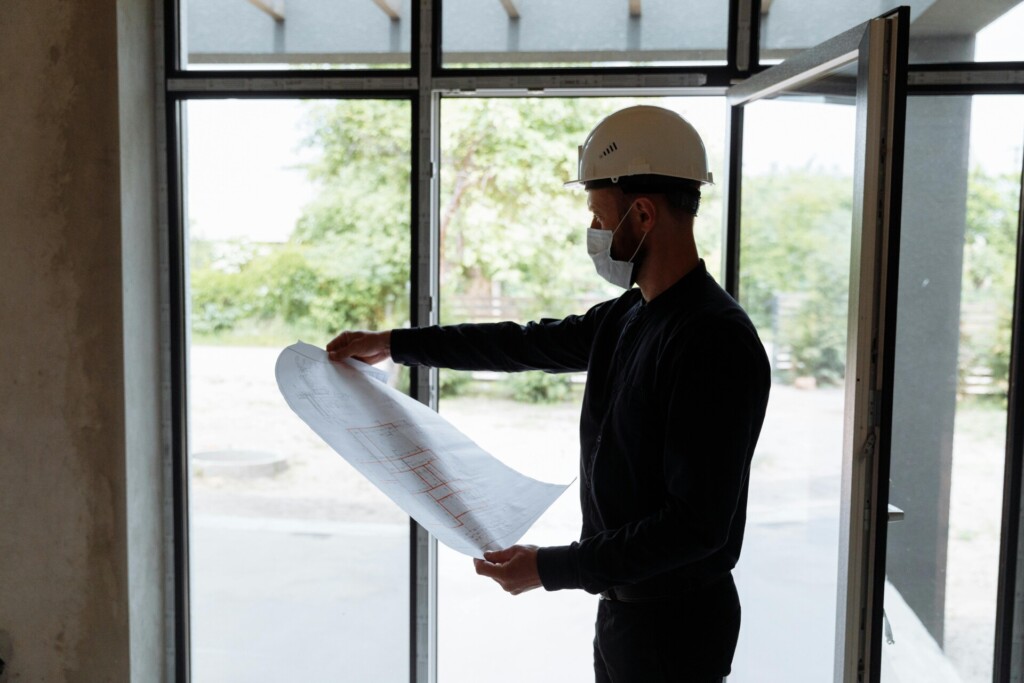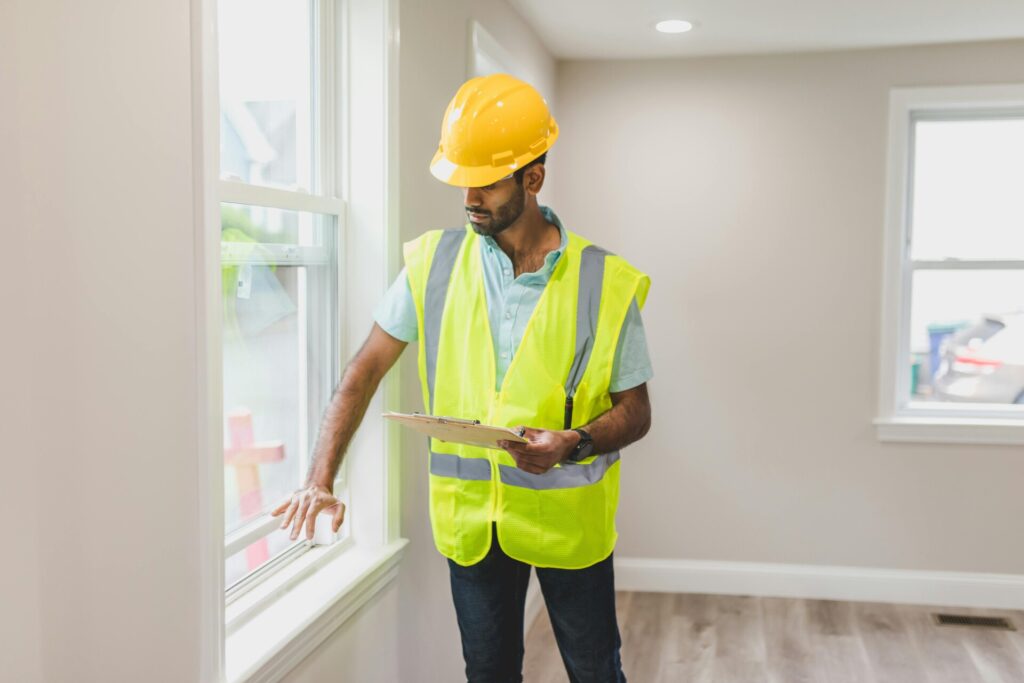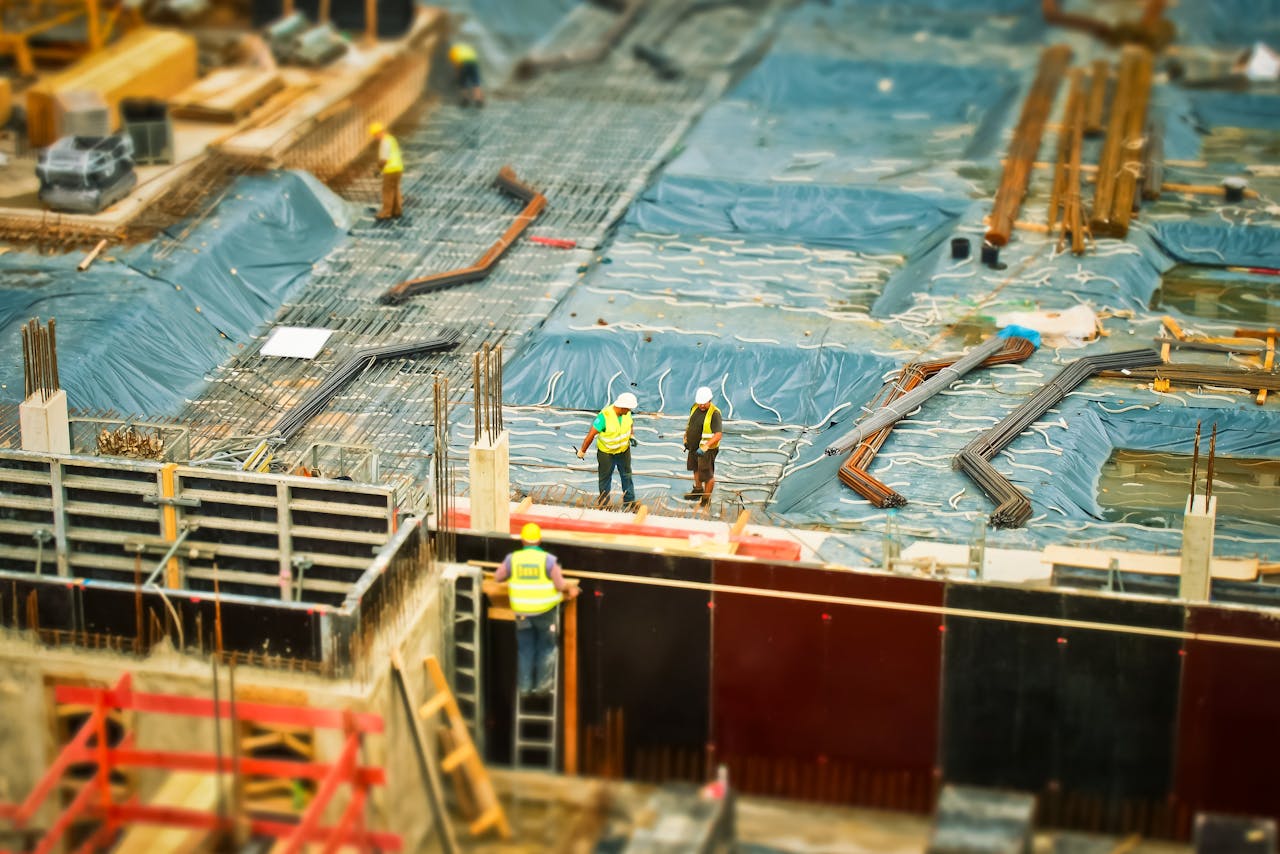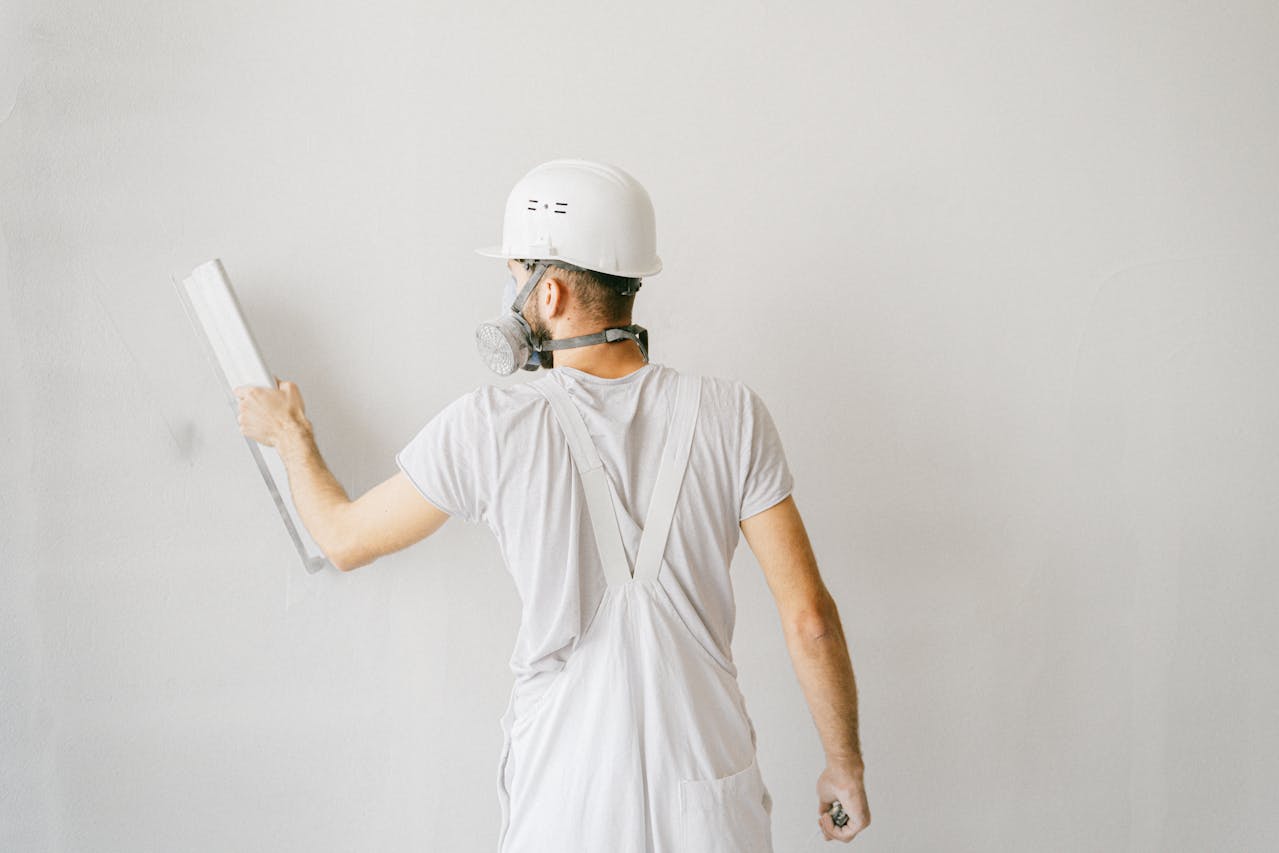Building on commercial property in Houston requires careful coordination between site conditions and the city’s permitting requirements. We evaluate each property using a comprehensive checklist that bridges what exists on the ground with what the Houston Permitting Center needs for approval.
Our site evaluation checklist for commercial property Houston covers documentation requirements like surveys, plot plans, and COMcheck reports alongside physical site assessments for safety hazards and emergency readiness. This dual approach ensures compliance with Building Code Enforcement standards while protecting project timelines.
What Permitting And Documentation Does Houston Require Before You Build?

Houston’s commercial permitting process requires specific steps and documents before construction begins. We coordinate these requirements during preconstruction planning to avoid delays and ensure compliance with city regulations.
Development Plat And Utility Coordination
We begin with a development plat review through Planning and Development’s Subdivisions Section. This review confirms that the proposed development aligns with Houston’s zoning requirements and subdivision standards.
Utility availability verification comes next through the Taps & Meters Section. We confirm water, wastewater, and storm drainage capacity before proceeding with design. This step prevents costly redesigns when utility connections prove inadequate for the project scope.
Core Permit Documents
The Building Permit Application forms the foundation of Houston’s Commercial Plan Review process. We prepare this application with detailed project information, including construction scope, occupancy type, and square footage calculations.
A COMcheck Report demonstrates International Energy Code compliance for all commercial projects. Since 2016, Houston has required complete COMcheck reports with all plan submissions. We ensure these reports include all required components because Houston rejects incomplete submissions at pre-screen.
The letter of utility availability from Taps & Meters confirms adequate infrastructure capacity. We obtain this letter early in the process since it impacts design decisions and construction phasing. A legal property description, typically obtained through tax office records or closing documents, establishes precise boundaries and ownership.
Storm Drainage Plans And Site Documentation
Storm drainage plans address Houston’s specific flooding concerns and drainage requirements. We design these systems to handle the city’s storm water management standards and coordinate with existing infrastructure.
ProjectDox serves as Houston’s electronic plan review platform. We upload all required documents through this system, including surveys that establish accurate property boundaries and existing conditions.
Plot plans based on the survey show proposed improvements in relation to property lines, setbacks, and existing structures. These plans guide both design review and field inspection processes.
Detailed Construction Plans
Floor plans with structural details demonstrate compliance with Houston’s building codes. We include load calculations, foundation systems, and framing details that support the proposed construction.
Electrical plans show added loads, line diagrams, and load analysis to verify adequate power distribution. These plans include panel schedules, circuit layouts, and emergency power systems when required.
Plumbing plans detail water supply, waste removal, and fixture locations. HVAC plans show heating, cooling, and ventilation systems sized for Houston’s climate demands.
An engineer’s seal validates technical drawings when Houston’s code requirements mandate professional oversight. We coordinate with licensed engineers to ensure proper certification of structural, electrical, and mechanical systems.
Specialized System Requirements
Health equipment details apply to food service establishments. We provide equipment specifications, installation details, and compliance documentation for commercial kitchens and food processing areas.
Fire alarm systems require detailed plans when building occupancy or size triggers these requirements. Electronic locks, when installed, need documentation showing integration with building security and emergency egress systems.
A soil report provides geotechnical data that influences foundation design and construction methods. We coordinate soil testing early in the design process to inform structural decisions.
COMcheck Compliance And Approval Process
Houston’s inspection checklist follows compliance certificates generated by the COMcheck report. We complete all required fields and include detailed comments because the approval process depends on this documentation.
Plan reviewers use COMcheck compliance certificates to verify energy code requirements during the formal review process. Incomplete reports trigger automatic rejection, extending project timelines and increasing costs.
Building Code Enforcement coordinates the overall review process, ensuring all submitted documents meet Houston’s construction standards. We maintain communication with reviewers throughout the approval process to address questions promptly and keep projects moving forward.
Which Site And Exterior Conditions Should You Check First?
Access And Topography
Site access determines how materials and equipment reach the construction area. We check road conditions, gate widths, and weight restrictions that could limit crane access or material delivery. Slopes affect drainage patterns and foundation requirements. Steep grades create runoff challenges that impact storm water management plans.
Drainage paths guide water flow during heavy rains common in Houston’s climate. We map existing drainage to identify potential flooding zones and confirm compliance with storm drainage requirements. Poor drainage creates foundation problems and delays construction schedules.
Soil And Geotechnical Conditions
Soil conditions directly affect foundation design and utility installation. We examine soil reports for bearing capacity, expansive clay content, and groundwater levels. Houston’s clay soils shift with moisture changes, requiring specific foundation approaches.
Geotechnical issues include soft spots, organic materials, and contaminated soil that affect construction methods. We identify areas needing soil stabilization or removal before construction begins. These conditions determine excavation requirements and foundation costs.
Structural Envelope Assessment
Foundation inspection reveals cracks, settling, or water penetration that affects structural integrity. We check for differential settlement patterns and moisture intrusion around the building perimeter. Foundation problems indicate soil movement or drainage failures.
Wall and roof conditions show weather damage, structural stress, and maintenance needs. We look for cracks in masonry, gaps in siding, and membrane damage on flat roofs. These issues affect building envelope performance and energy efficiency.
Openings And Interior Access Points
Windows and doors require testing for proper operation, weatherproofing, and structural soundness. We check for broken seals, drafts, and hardware failures that compromise building security. Window frames show water damage through discoloration and warping.
Floor conditions reveal structural problems through unevenness, soft spots, and moisture damage. We test for bouncing or deflection that indicates structural issues. Moisture problems appear as staining, mold growth, or musty odors.
Roof And Gutter Systems
Roof materials show storm damage through missing shingles, membrane tears, or metal corrosion. We inspect flashing around penetrations and edges where water typically enters. Flat roofs require checks for ponding water and membrane deterioration.
Gutter systems manage water flow away from the foundation during heavy rains. We test downspouts by flushing water through the system and checking for proper anchoring. Blocked gutters create overflow conditions that damage building exteriors and foundations.
Exterior Grounds And Infrastructure
Parking lots and driveways affect site access and stormwater management. We check for potholes, cracking, and drainage issues that create safety hazards. Uneven pavement indicates base failure or poor installation.
Fencing and signage provide security and code compliance for commercial properties. We verify fence condition, gate operation, and proper mounting. Landscaping affects drainage patterns and building protection through tree placement and ground cover.
Site Safety Conditions
Uneven terrain creates fall hazards during construction activities. We flag areas needing grading or temporary protection barriers. Exposed electrical wires and unsecured materials pose immediate safety risks requiring correction before work begins.
PPE compliance and emergency readiness ensure worker safety during site evaluation and construction. We verify access to safety equipment and emergency procedures. Proper safety measures prevent accidents and regulatory violations during construction phases.
How Should You Evaluate Building Systems And Life Safety?

We approach building systems evaluation with a methodical assessment of each critical component. This systematic review ensures every system meets safety standards and operational requirements before construction begins. Our evaluation process covers electrical infrastructure, plumbing networks, HVAC capacity, and fire safety systems.
Electrical System Assessment
We start with electrical panels and switchgear, checking for code compliance and adequate load capacity. Circuit breakers require proper labeling and testing for correct operation. Wiring inspections focus on conductor integrity, connection tightness, and proper routing through the structure.
Power surge resistance becomes critical in Texas due to frequent storms and electrical disturbances. We verify surge protection devices are properly installed and functioning. Load calculations must match the electrical service capacity to prevent overloading during peak demand periods.
Interior and emergency lighting testing covers all fixtures, including backup power systems. We test each outlet and switch for proper polarity, grounding, and GFCI protection where required. Emergency backup lighting must activate within ten seconds of power failure and maintain illumination for at least ninety minutes.
Plumbing System Evaluation
Pipe inspection covers the entire distribution system, looking for corrosion, leaks, and proper material selection. We test water pressure at multiple fixtures to ensure consistent flow throughout the building. Pressure readings should meet minimum requirements while avoiding excessive levels that could damage fixtures.
Restroom facilities receive detailed attention, with checks on water closets, lavatories, and accessibility features. Sewage and drainage systems require verification of proper slope, venting, and connection to municipal systems. We test drainage performance under load conditions to identify potential backups.
Hot water systems need capacity verification for the intended occupancy load. Distribution piping insulation prevents heat loss and condensation issues in Houston’s humid climate.
HVAC Capacity And Performance
Heating and cooling capacity evaluation addresses Houston’s extreme weather conditions, from summer temperatures exceeding 100 degrees to occasional winter freezes. We calculate load requirements based on square footage, occupancy, and equipment loads. System sizing must handle peak demand without excessive energy consumption.
Filter and ventilation inspections ensure clean airflow throughout the building. Ductwork requires proper sealing and insulation to prevent energy loss and moisture problems. Air handlers and outdoor units need adequate clearance for maintenance and proper operation.
Thermostat placement and zoning controls allow for efficient temperature management across different building areas. We verify refrigerant levels and electrical connections on all HVAC equipment.
Fire And Emergency Systems Verification
We confirm fire alarms and sprinklers meet NFPA standards and local code requirements. Fire alarm systems require proper detector placement, audible and visual notification devices, and connection to monitoring services. Control panels need clear labeling and accessible locations for emergency responders.
Sprinkler system evaluation includes water pressure testing, proper head spacing, and coverage areas. We verify water supply adequacy and backflow prevention devices. Fire pump systems require regular testing and maintenance schedules.
Exit signs and emergency lighting receive functional testing during simulated power outages. Battery backup systems must maintain illumination for required durations. We check egress paths for proper lighting levels and unobstructed access to exits.
Fire extinguisher placement follows NFPA 10 requirements for coverage areas and accessibility. We document inspection dates and service records for all fire safety equipment. Emergency communication systems require integration with building alarm systems for coordinated response during emergencies.
What Environmental, Health, And Compliance Risks Should You Screen?
Moisture And Humidity Hazards
We assess moisture-related issues that frequently develop in Houston’s high humidity climate. Mold and mildew growth accelerates when interior spaces lack adequate ventilation or have water intrusion from leaks or poor drainage. These conditions create respiratory risks for occupants and can compromise structural integrity over time.
Property owners should document visible mold colonies, musty odors, and areas with persistent dampness. We examine HVAC systems for proper moisture control and check interior surfaces near plumbing fixtures, windows, and exterior walls where condensation commonly occurs.
Legacy Material Testing Requirements
The City of Houston mandates specific testing protocols for older commercial properties that may contain hazardous materials. Lead-based paint testing becomes necessary for buildings constructed before 1978, as federal regulations limited residential lead paint use starting that year. Properties built between 1930 and 1980 often require asbestos testing, particularly in insulation, floor tiles, and roofing materials.
When testing confirms the presence of these materials, EPA regulations require proper abatement and disposal procedures. We coordinate with certified professionals who handle removal and ensure compliance with both federal and local disposal requirements. Documentation of proper abatement becomes critical for permitting approval and future liability protection.
Pest And Termite Inspections
Commercial properties require systematic pest screening that addresses both immediate infestations and conditions that attract future problems. We check for rodent entry points, insect activity, and structural damage from previous infestations. Food service facilities need particular attention to areas where pests commonly enter and breed.
Termite inspection demands special focus during Houston’s warm seasons when these wood-destroying insects remain most active. We examine structural lumber, foundation areas, and wood-to-soil contact points where termite colonies typically establish. Early detection prevents costly structural repairs and ensures compliance with insurance requirements.
Accessibility And Building Code Compliance
ADA compliance verification involves systematic review of entryways, interior pathways, restroom facilities, and parking areas. We measure door widths, ramp slopes, and clearance requirements that must meet federal accessibility standards. Commercial facilities serving the public face strict compliance requirements with potential penalties for violations.
Local and state building codes require verification beyond basic accessibility. We confirm that structural modifications, electrical upgrades, and plumbing changes align with current code requirements. Properties with mixed-use occupancy need review against multiple code classifications that may apply to different areas of the building.
Energy Code Documentation
COMcheck reports provide mandatory energy code compliance documentation that Houston requires for plan approval. We verify that building envelope components, HVAC systems, and lighting installations meet current energy efficiency standards. Incomplete or inaccurate COMcheck submissions trigger plan rejections that delay project timelines.
The energy compliance review examines insulation values, window performance ratings, and equipment efficiency specifications. We ensure all documentation aligns with the actual installed systems and meets the specific energy code requirements that apply to the project’s occupancy classification and building size.
Conclusion And Next Steps

A thorough commercial site evaluation creates the foundation for successful Houston permitting and construction. We use this systematic approach to reduce project delays and ensure regulatory compliance from the outset. The checklist format keeps critical assessments organized and provides clear documentation that supports ProjectDox submission requirements.
We begin by collecting core documentation including the survey, plot plan, comprehensive floor plans, storm drainage plans, soil report, and COMcheck energy compliance report. Our teams then conduct systematic on-site evaluations covering structural conditions, safety hazards, and system performance. Environmental screenings for mold, termite activity, and legacy materials like lead-based paint or asbestos follow established protocols, with proper abatement and disposal procedures when required. ADA compliance verification and building code alignment complete the assessment process before coordinating with Planning and Development and Taps & Meters for final plan submission.
Regular site evaluations using this structured approach help projects move through Houston’s approval process more efficiently while maintaining safety standards and regulatory compliance. Contact EB3 Construction to discuss how we can support your commercial property development needs.




